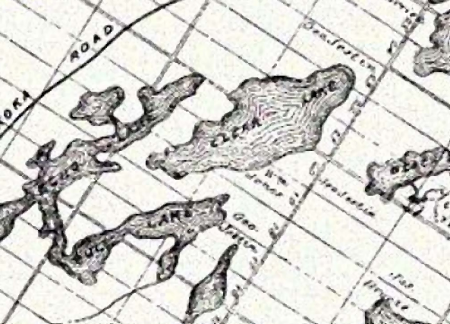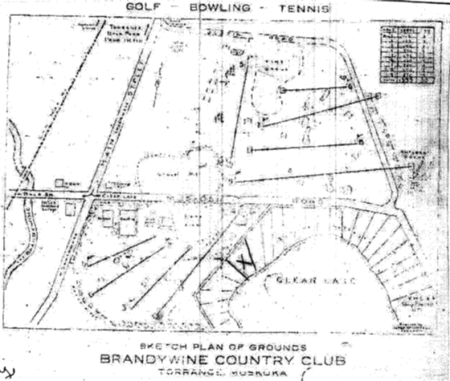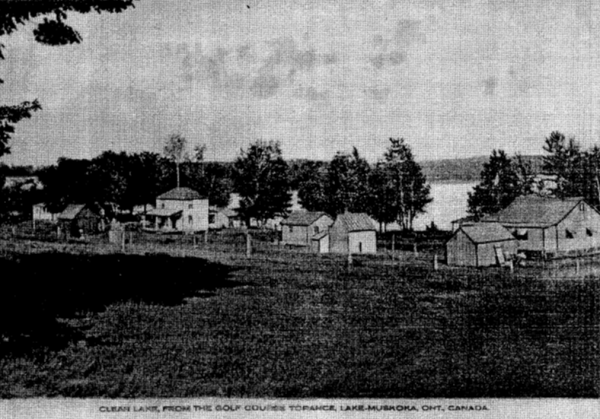|
Geological History
Some 45,000 years ago Clear Lake was formed by one of the bottom-dragging
retreating and melting glaciers. Glaciers formed lakes by cutting holes in
loose soil or soft bedrock, depositing material, or leaving buried chunks of
ice. These chucks of ice melted to leave lake basins. When these gaps or holes
filled with water, they became lakes.
The primary role of these glaciers, in lake formation, was simply to act as
large dump trucks, bringing in enormous volumes of clastic sediment (rocks from
other areas where it was then redistributed by 'normal' sedimentary processes).
The result was the large scours with a sand bottom with a few large rock dumps;
we call the largest "the shoals".
First settlers to the area
The story of the first settlers around today's village of Torrance in Wood
Township was told in "The Early History of Torrance", a booklet by Mrs. G. R.
Jestin, dated December 1938 published by the WI (Womens Institute).
Wood township was opened for settlement in 1869, and Mrs. Jestin
tells about three men from Eramosa, a village near Guelph in southern Ontario,
who travelled to Muskoka that summer to investigate the government offer of
free land. They were a hardware merchant, William Torrance, and two farmers,
Joseph Coulter and George Jestin, who took the train to Orillia and then a
stagecoach to Gravenhurst. From Gravenhurst the steamer "Wenonah" took them
part way up Lake Muskoka and they disembarked on the west shore. The country
was rough and rocky, full of lakes and streams, the trees untouched by the
lumberman s axe. Old Indian trapping trails through the woods guided them from
lake to lake. Two locations were chosen on Lake Muskoka and one on Clear Lake.
Before returning south to Eramosa, Torrance and Coulter stayed
long enough that summer to build their own log houses. Jestin's house on Clear
Lake was to be built by the only other man the three settlers had found in the
area, a French-Canadian lumberman named Jannack, who had a log house on an
island later named Bala Park. (The narrows at the south end of Bala Park Island
are shown on today's maps as "Jeannette" but local people use the name "Jannack
Narrows", which appears to be historically correct.)
The three men returned a year later with their families and
supplies and each bought 100 acres of land for 75 cents.
Torrance
In 1875 when the settlers petitioned for a post office, William
Torrance was appointed Postmaster and the hamlet took his name. The mail was
then brought from Gravenhurst by steamer in the summer and by stagecoach in
winter, for by this time the Musquosh Road from Gravenhurst (the "old
Gravenhurst" road) to Port Carling up the west side of Lake Muskoka was well
under way.
The first settlers on Clear Lake
Although hunters and natives likely camped on our shores, the first settler we
know of was George (Geo) Jestin who bought the southern bay.
William George Jestin and Mary Ann Jestin and sons, William, Richard, daughters
Jane and Rebecca settled in 1869. When the history was written (sometime in the
1960s) the book said Mrs. W.H. Bailey still lived on Clear Lake near the
homestead, but it isn't clear if any remains of the homestead are still there.

Map of Original Land Grants for Clear Lake
The next Clear Lake settler family was that of Jno. Pearce (as written on the
original documents).
In 1878 Oalf Willison came from Sweden and started a Swedish settlement around
Gull and Clear Lakes. He was followed by the Charles Stromberg family, and
Oalf's son Peter.
Musquash road was built past Clear, Gull and Long Lakes over the burnt rocks as
far south as Gravenhurst and around Muskoka Lake to Port Carling.
The rail service to Gravenhurst arrived in 1875, however rail service didn't
come to this area until 1906. "Queens Walk Road", as the community calls it, is
the only stop that Queen Elizabeth II made in West Muskoka when she visited in
1959.
More people arrived in this area by train and until the 1970's there was a small
station on Queen's Walk road just beside the tracks. Trains used to stop there
on a twice daily basis with and additional stop on weekends.
When people began to use cars they used what is now known as the "Old
Gravenhurst" road which ran down Clear Lake Road, split to the left at the YMCA
camp junction and went beside Gullwing, then Skunk (or Stink) Lakes. That road
is now blocked by a beaver dam and has been impassable to cars for quite a few
years.
First cottages
Cottages started to appear on the lake around the turn of the 20th century along
the shore of southern Bay. The first "cottager" was likely a WG Rook, who
bought a portion of land and build a stone cottage which he designed as a "club
house" for a Clear Lake golf course. He may have built a 3 hole course include
scan of golf course and photo of cottages but the club wasn't successful. He
also constructed the sidewalk that runs through Torrance parallel with the
highway, covering it with cinders, which was no fun to walk on hot summer days.
Rook's old cottage burnt down in the 1980's and the Meadows currently own and
live on the property.

Sketch of Golf Course

Clear Lake From The Golf Course, Torrance, Lake Muskoka, Ont, Canada
The next earliest was likely the Maitland/Squire/Pell/McClennan cottage now
owned by Mina and Mike McClennan at 1026-1 Clear Lake Road built in 1902. This
was closely followed by the Lithgow's, the Ramsay's, the Lennie's, the other
McClennan cottage (Charlie Keane's), the Watson's and the Algate's.
Poem
This poem was written by Prof. N. Willison, son of Oalf Willison, in the late 1800's.
Clear Lake! the brightest jewel of the gems
That crown Muskoka's brow! -- in all the world,
What fairer lake could be? -- a diamond rare,
Set in the bosom of an emerald.
I love thee for thy beauty; when the sun
Has kissed thy dancing ripples, or the moon
Has laid her silver train across thy breast,
The soft-eyed stars attending -- and it's June.
I love thee for they breezes that have climbed
A thousand feet to play and dance with thee,
The while caressing rocks so old, they say
That none before them rose above the sea.
I love thy limpid waters most of all,
Through which I oft have seen the golden fish
With graceful glide disdain my clumsy art,
Preferring life and lake to angler's dish.
I learned to swim just off that little isle
That rises from a bed of silv'ry sand,
Five feet or more, close to those hemlock trees
And pines that bear thy greetings to the land.
My rustic boat with heavy oars I plied
On thee so lustily and feared thee not,
Though in thy mirrored depths I saw the clouds
Of heaven pass, or with the storm-gale fought.
And then 'twas on thy breast love dawned to me --
Soft stars o'er head, and evening redolent
With fragrence from arubtus-covered shores,
And music in the heart that heaven sent.
I love thee, yes, because near thee was home --
Just home! the dearest of all realms of yore! --
Where father lived, and mother, and we all;
Fresh air, freedom, and love, our treasure store.
I love thee, and when my own life shall close
And men shall ask, "Where should he now be laid?"
I pray that God may so in their hearts incline
That near thy waters I may rest my head.
Mike McClennan has volunteered to be our 'official' Clear Lake historian and to
gather a composite of stories and pictures of our lake history. If you know
when your cottage was built, have some old pictures or some interesting
stories, please pass them on to Mike (
).
We will scan the pictures and return them to you. Mike will also be around the
lake this summer looking for your input so please help him archive our past.
|

































